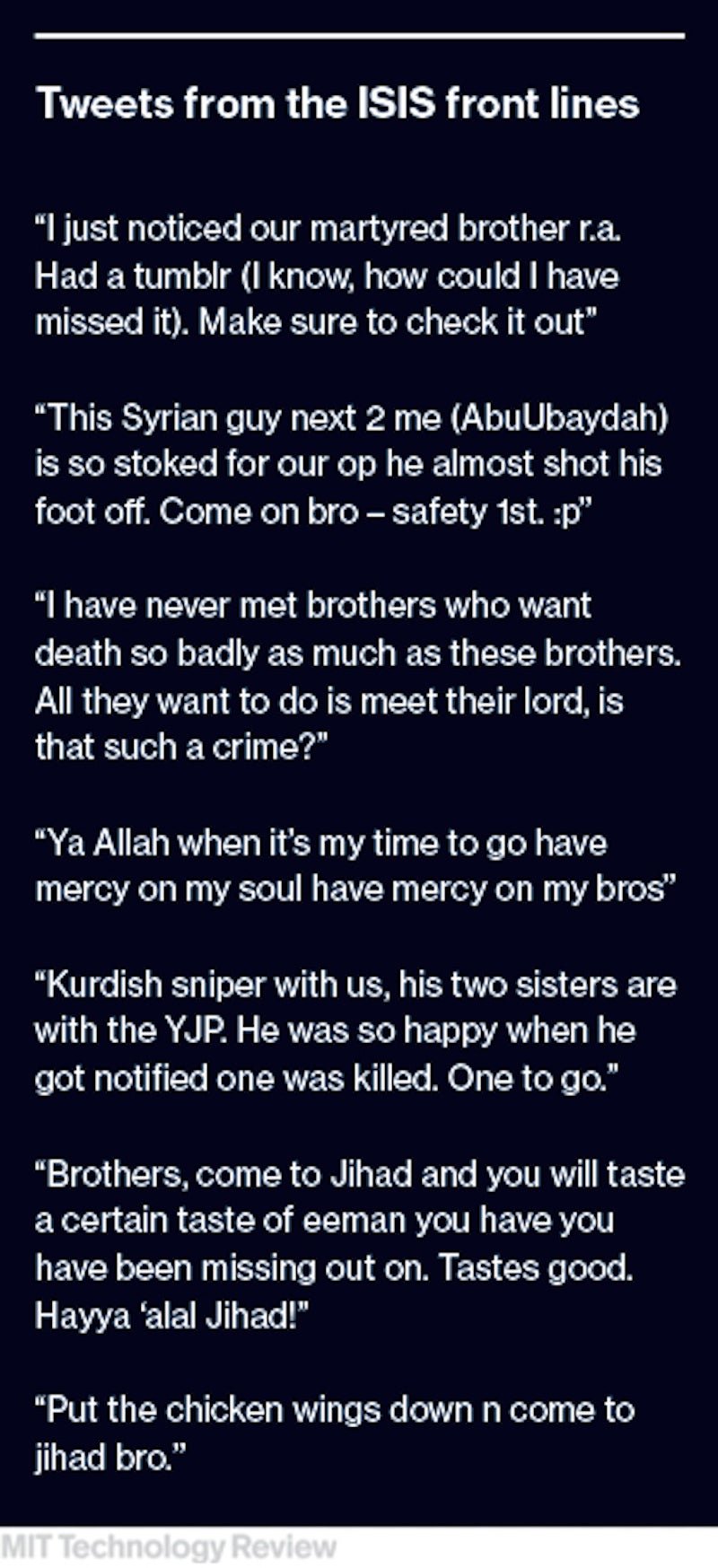This man went head-to-head with ISIS sympathizers on social media and won
This piece originally appeared at the MIT Technology Review.


This piece originally appeared at the MIT Technology Review.
The two men pecked out messages on opposite sides of the country. “Yes the Islamic State was a fantasy in 2004, now look at it. The U.S. was a fantasy in 1776, now look at it,” the man in Virginia wrote in a Twitter direct message to an online friend in Oregon. The Virginian, who went by various Twitter handles, including one with “Jihadi” in it, had been obsessively watching slick online videos produced by the Islamic State, also known as ISIS: brutality and jihadist propaganda, much of it translated into English and other languages. Now he was talking about traveling to Syria and forming a militia in Virginia. “Washington beat an empire with 3 percent of the population. I can do it with 1 percent.”
His correspondent in Oregon was Paul Dietrich, a programmer and digital activist joining jihad-related Twitter conversations out of curiosity. Alarmed, he did what relatively few are doing: he tried to intervene with someone who was showing signs of being radicalized by ISIS’s social-media campaign. Dietrich heard the man’s grievances sympathetically, tried to talk common sense, and suggested he get psychological help. Then one night he called the Virginia man “stupid.”
“How am I stupid?” he responded.
“Let me count the ways. You are a jihadist, in America, who wants to start a militia, and you think you’ll win,” Dietrich wrote. “Stop. This. Madness. While. You. Can.”
The Virginia man was, at least, talking. “I’ll think about it.”
Extremist groups have long used the Internet, and citizens have long left home to fight for their countries’ enemies. But ISIS stands apart in the way it’s mastered online propaganda and recruitment. Using 21st-century technology to promote a medieval ideology involving mass killings, torture, rape, enslavement, and destruction of antiquities, ISIS has been the prime mover among Islamist groups that have lured 25,000 foreigners to fight in Syria and Iraq, including 4,500 from Europe and North America, according to a US government report released this week. “The ISIS social-media campaign is a fundamental game changer in terms of mobilizing people to an extremist cause,” says Amarnath Amarasingam, a researcher at the University of Waterloo who is co-directing a study of Western fighters in Syria. “You are seeing foreign fighters from 80 or 90 countries. In terms of numbers and diversity, it has been quite stunning.” As Google’s policy director, Victoria Grand, told a conference in Europe in June: “ISIS is having a viral moment on social media, and the countervailing viewpoints are nowhere near strong enough to oppose them.”

Indeed, the technological response to stanching the recruitment isn’t having much of an effect. Internet companies close accounts and delete gory videos; they share information with law enforcement. Government agencies tweet out countermessages and fund general outreach efforts in Muslim communities. Various NGOs train religious and community leaders in how to rebut ISIS messaging, and they create websites with peaceful interpretations of the Quran. But what’s missing is a widespread effort to establish one-on-one contact online with the people who are absorbing content from ISIS and other extremist groups and becoming radicalized.
Humera Khan, executive director of Muflehun (Arabic for “those who will be successful”), a Washington, D.C., think tank devoted to fighting Islamic extremism, says people like her and Dietrich who try such online interventions face daunting math. “The ones who are doing these engagements number only in the tens. That is not sufficient. Just looking at ISIS-supporting social-media accounts—those numbers are several orders of magnitude larger,” says Khan. “In terms of recruiting, ISIS is one of the loudest voices. Their message is sexy, and there is very little effective response out there. Most of the government response isn’t interactive. It’s a one-way broadcast, not a dialogue.”
Reversing the tide will require, among other things, much more of what Khan and Dietrich have done. What’s needed is better ways to identify the people most at risk of being persuaded by extremist messages and more reliable ways to communicate with them. As an example, a London think tank called the Institute for Strategic Dialogue recently piloted experiments in which it found people at risk of radicalization on Facebook and tried to steer 160 of them away. It was a small test, but it shows what a comprehensive peer-to-peer strategy against extremism could look like.
Distribution mechanisms
ISIS differs from previous radical Islamic movements. For one thing, it forged important alliances to capture territory. After merging al-Qaeda factions with elements of Saddam Hussein’s military and intelligence agencies, it seized two major cities, Raqqa in Syria and Mosul in Iraq—a region with more than six million inhabitants (at least before the latest mass migrations), substantial resources of oil, water, and wheat, and institutions such as universities. Al-Qaeda, in contrast, never controlled more than a few pockets of territory in such places as Somalia and Yemen. “Never before had a jihadist movement gained the kind of territory and wealth that might allow them to function like states and run public relations campaigns,” says Nico Prucha, a researcher at the University of Vienna and a fellow at the International Center for the Study of Radicalization at King’s College London.
Second, ISIS differs ideologically from other jihadist groups. A few days after ISIS grabbed Mosul in 2014, a stern-faced, black-robed man ascended stone steps in a mosque and claimed the grandest title of them all: “Caliph,” leader of all Muslims, successor to the Prophet Muhammad, with aims to unite Muslim lands into a caliphate much like the ones that rose and fell in the first millennium. The man was Abu Bakr al-Baghdadi, ISIS’s leader. He had cleverly attached his extremist cause to a larger idea that resonates with many Muslims: the restoration of the caliphate.
“Really, you are dealing with a social movement in the true sense—it’s no longer just ‘a group’ that people are joining,” says Mubin Shaikh, a former extremist in Toronto. He has worked undercover for Canadian intelligence services on several investigations, one of which involved infiltrating the “Toronto 18,” a group of young Muslims charged with planning terror attacks in 2006. Today, he also advises U.S. counterterrorism agencies and tries to intervene online to stop young people in Toronto’s Muslim community—the largest in North America—from becoming radicalized.
“People will make analogies to fighters joining the Spanish Civil War,” Shaikh says. “While I understand the analogy, I don’t think it applies. This is really peculiar to the Muslim context. The Muslim world—especially the young Muslim world—has been psychologically primed for a long time to the idea of reëstablishing the caliphate. It’s this idea that Muslims are living under humiliation, and the only time we were not is when there was a caliph. It really is an idea of reclaiming lost glory.”
Third, ISIS emerged after important technological shifts. Think back to when terrorists made their first beheading video, in 2004. According to the CIA, this grainy and gruesome piece of media likely shows Abu Musab al-Zarqawi (the leader of al-Qaeda’s branch in Iraq, which later morphed into ISIS’s predecessor) slaughtering Nick Berg, a radio entrepreneur from Pennsylvania. It was a laborious task to upload this file onto a jihadist Web forum. There was no YouTube or Twitter to allow instant sharing of videos or links to them. Facebook was still a dorm-room plaything. Few people had smartphones. Al-Qaeda used news organizations such as Al Jazeera to release its videos and statements. Today, however, affordable devices, fast networks, and abundant social-media accounts directly feed a spectacularly large potential audience of young people. A recent study found that the world’s 1.6 billion Muslims have a median age of 23.
The notional head of ISIS’s media operations is a 36-year-old Syrian named Abu Amr al-Shami, who had been the ISIS boss in Aleppo, according to the Soufan Group, a consultancy whose leaders include former U.S. and U.K. counterterrorism officials. The propaganda effort includes a slick online magazine called Dabiq. And there’s a division called Al Hayat Media, which targets Western audiences. It’s run by a German rapper formerly known as Deso Dogg who now calls himself Abu Talha al-Almani, according to the Middle East Media Research Institute. His oeuvre includes recruitment videos, called Mujatweets, in which you might see fighters handing out ice cream to children.
But the larger social-media campaign is aided by sympathizers in the Middle East, North Africa, and elsewhere who produce their own content in multiple languages. This decentralized approach makes it hard to go after the people producing it. “They can do this anonymously from wherever they live,” says J. M. Berger, a nonresident fellow in the Project on US Relations with the Islamic World at the Brookings Institution and coauthor of a paper called “The ISIS Twitter Census.”

The propaganda consists of more than graphic videos; it adroitly addresses national, local, and tribal grievances. For example, on February 3, videos surfaced of ISIS soldiers forcing a captured Jordanian fighter pilot, Moaz al-Kasasbeh, into a metal cage—and then burning him to death. Western media reports focused on the deed’s barbarity, but the fire starts 18 minutes into the video. The bulk of it lays out a detailed argument for the act, making connections between President Obama and Jordanian leaders; between American-made armaments and Jordanian air strikes on ISIS; and between those air strikes and the dead and bloodied on the ground in Raqqa. Under the logic of “an eye for an eye,” ISIS had a justification for the fighter pilot’s execution, and the act had a clear political goal as well, Prucha explains. It was designed to drive a wedge between King Abdullah of Jordan, who is close to al-Kasasbeh’s uncle, and the many refugees from such airstrikes who are living in the country. For good measure, the text was translated into French, English, and Russian.
The propaganda put out by Dabiq, the ISIS magazine, includes articles geared to certain audience segments. Recruitment pitches for women, for instance, emphasize themes of sisterhood and belonging—and highlight the role of marriage and family in bolstering “Brand Caliphate,” as Sasha Havlicek, founder of the Institute for Strategic Dialogue, puts it. As potential recruits are wooed, ISIS supporters engage them in one-on-one chats that are often steered to all-encrypted channels.
In trying to understand why ISIS is so adept at all this, one comes back to a simple explanation. The people doing it grew up using the tools. “When you say ‘terrorist use of social media,’ it sounds ominous, but when you look at it as ‘youth use of social media,’ it becomes easier to understand,” says Khan. “Of course they are using social media! They are doing the same thing youth are doing everywhere.”
Scaling up
As he pulls up to meet me at the Toronto City Airport in his cluttered Dodge Caravan, Shaikh, with his gray-flecked pencil sideburns, looks like the 40-year-old, minivan-driving father of five that he is. Two decades ago, however, he was a disaffected, hard-partying Toronto punk who latched onto Islamic extremism. So he understands ISIS’s target audience today. And like Dietrich and Khan, he sometimes tries to tackle the exhausting task of engaging online.
At one point, to attract possible extremist followers, he created a Twitter username, “@CaliphateCop” (he later deleted it, but now the name is used by another Twitter user), and included a quote from the Quran in his profile. He would jump into Twitter conversations and soon engaged with many people professing support for extremist causes. One was, Shaikh says, an al-Qaeda supporter in Syria. “How can you sleep at night knowing Muslims are in prison due to your snitching?” the Syrian wrote. Shaikh shot back: “How can U claim any sort of Islam and accept the random killing of civilians? Where the heck did U learn your religion?”
“Allah Al Musta-an!!” (roughly equivalent to “Oh my God!”) came the reply. “Canada participated in the destruction of the Islamic emirate, they have no innocents for their crime.”
Shaikh countered: “Really? Random people walking2work who hav zero attachment2 what govt does—they’re legit targets?”
The Syrian had his rationalization ready: “Who was the first person in Islam to use the catapult? It was the prophet. And we both know the catapult doesn’t only hit enemy combatants.”
Social-media research has shown that messages from friends and peers are more persuasive than general advertising. Other bodies of research show that youth at risk of falling into many kinds of trouble, from drugs to gangs, often benefit from even small interventions by parents, mentors, or peers.

But so far, major anti-ISIS programs don’t involve that kinds of outreach. For example, over the summer the British government launched a tweet campaign to broadcast government messages against ISIS. Some $188 million from U.S. government agencies funds anti-extremist projects and other community-engagement programs around the world, including one aimed at stanching recruitment inside prisons. And there are efforts to develop new social technologies. Affinis Labs, based in Arlington, Virginia, describes itself as a Y Combinator–like incubator for Muslim-centric apps. One is “QuickFiqh,” in which youths ask 60-second questions about Islamic law and get 60-second answers from mainstream Islamic scholars, made to be easily shared on social media. But these efforts are aimed at Muslims more generally and don’t specifically target people showing signs of becoming radicalized.
Shaikh and others doing peer-to-peer work say they’re frustrated because they can’t know whether the people they talk to online are the ones most at risk or are too far gone and thus a waste of effort. They also want more evidence about what approaches and messages are most effective. So this year the Institute for Strategic Dialogue decided to develop a systematic peer-to-peer anti-extremism strategy. First the group recruited 10 former extremists (five from far-right groups, five from jihadist groups) to serve as “interveners.” Next, they used a Facebook feature called Graph Search to find people whose interests, pages liked, group memberships, and other indicators showed they were likely to be moving toward extremism. The interveners winnowed the list to 160 people and used a little-known “pay per message” feature (you can pay $1 to send a message to a stranger) to start a dialogue. The preliminary results showed that most recipients responded, a crucial first step. Some 60 percent started a “sustained engagement” when the initial overture was nonjudgmental and empathetic.
The study pointed, in a crude way, to what might be possible at a larger scale. “Social media has assisted extremist causes, but there are many ways for us to push back using the same tools,” says Ross Frenett, who led the study. “We just haven’t optimized that. We haven’t pursued that.”
Today, ISIS still dominates in the online struggle. Young people continue to leave Western countries for the battle zone. But every now and then, there are small victories. Khan and Dietrich say the young man in Virginia is seeking mental health treatment. Though known to the FBI, he has not been charged with any crime. Having started down the path of radicalization, he may be on his way back because of a few people talking to him online, one on one.